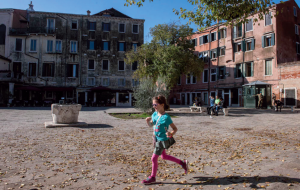EVENTS Venice, When History Deserves Consciousness Raising
Venetian Ghetto has got a very peculiar history, compared to other Jewish communities which have experienced a similar condition of forced segregation during the long Jewish diaspora. Despite being Venice the brain behind the creation of ghettos, inside the physically relegated Venetian Jewish community a cultural environment characterized by the interaction between the community itself and the external world flourished; this is not what happened in Rome, where the Church imposed miserable conditions of life and constant harassment over the Ghetto inhabitants, causing social and cultural backwardness. This is why the unique history of the Ghetto of Venice is a history of consciousness-raising related to the “other”. The delicate condition of the Venetian Jewish community represents a crossroads that made people come to tough and uncompromising decisions that, at the same time, were open to the external world. Intellectuals and Rabbis, like Leon of Modena (1571-1648), witnessed the fact that there was a positive side in their belonging to the Jewish minority because, having they consciously chosen to affirm their diversity, they also had to protect and emancipate it from the idea of marginalization and frustration. For instance, in Leon of Modena’s religious academy singing, dancing, writing and Latin lessons were introduced, in an attempt to balance religious and secular education. Even though the Ghetto was poky and enclosed by gates, Jewish people could go out during the day, buy books, work and visit friends, while the non-Jewish were used to get into the Ghetto so as to attend lectures and sermons given by rabbis. At that time many Talmudic academies were being opened inside the Ghetto and, thanks to the renown of their rabbis, they achieved such a resonance that they transformed Venice into the heart of European Jewish culture. Thanks to the awareness of being witnesses of important cultural and religious traditions, the Jewish community of Venice felt sufficiently protected; obviously, some of them abandoned the distinctive elements of Judaism. However, if we examine the history of Jewish presence in Venice, it is clear that one of the community’s strong points was its capability of taking out and assimilating the external world without being absorbed by it and adapting its response to the changing world. Nowadays, in Venice there are almost 500 Jewish people who still preserve characteristic and interesting features which are not easily traceable in other communities, because of their history. Contrary to what happened in other Italian cities, Venetian Jewish people have lived in this Ghetto for centuries and, due to the low number of migrations, they can actually call themselves “Venetians”. They have developed an unusual kind of minority “national pride” and, as a result of their tenacious commitment, their Venetian identity has been fully recognized, which is a fundamental right for those who have been living in the same place for ages. In addition, many among them still speak the Venetian Jewish dialect, and this shows how deeply blended their Jewish and Venetian identity are. Since the dialect was unintelligible to the non-Jewish Venetians, it was used as a secret element of defense against the distrustful environment that surrounded them. At the same time, it orally conveyed the cultural heritage that had been created during their centenary life inside the Ghetto and so it had both a psychological and a social function. Today, there are still lots of bonds which are handed down from generation to generation. One of this bonds is clearly the fact that they identify themselves with a specific place, which represents the historical memory of the Venetian Jewish community, which is made up by people of different origins and extractions. Even though there have been some tensions, this multicultural situation matches the centuries-old Venetian policy, in which the Jewish community rightfully fits, having been for the last 500 years an integral part of Venetian culture, and in which the bridges, not only the architectural ones, connect the many expressions of Judaism (Sephardic, Ashkenazi, Levantine, Italian) to non-Jewish culture. Venetian Ghetto is a place that recalls the miraculous survival of a small minority that decided to side with life, without giving up on their values, and refused to be humiliated by segregation.
*Roberto Della Rocca is a rabbi. A version of this article was published, in Italian, on the printed issue of Pagine Ebraiche. The article has been translated by Ilaria Modena, student at the Scuola superiore interpreti e traduttori di Trieste, who is doing her apprenticeship in the newsroom of Pagine Ebraiche.

